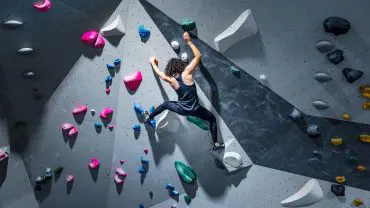Not only is karate an incredibly effective method of self-defence, like many martials arts emanating from the Far East it’s also a way of life. It promotes positive values such as self-discipline and respect, as well as numerous health and fitness benefits.
Here, we’ll answer ‘what do you do in karate’ as well as ‘what are the belts in karate.’
A Short History of Karate

Man practising Karate kick along beach at sunset (Photo: Allan Baxter via Getty Images)
The history of karate is shrouded in mystery. However it’s believed to have been established in the 1300s when early practitioners moved from mainland China to the Okinawa islands (then known as the Ryukyu Kingdom) around 400 miles to the south of the Japanese mainland.
Weapons were banned in the kingdom, so locals gathered to create a type of combat that incorporated the ability to defend but also to focus on personal development both physically and mentally. Then as now, teachers emphasised the principle of ‘no first strike.’
There was nothing formal about the early forms of karate, and it’s even unlikely they could have answered the question ‘what is karate’ back then.
Fast-forward to the late nineteenth century and many Okinawans moved to the Japanese mainland. Among them was Gichin Funakoshi, a quiet schoolteacher, poet and student of Confucius, who introduced karate to Japan in 1922. He was the founder of Shotokan karate in the 1930s, the most popular style of karate, and he is known as the ‘father of modern karate’.
Interestingly, karate was only formally accepted as a traditional Japanese martial art in 1935, and the Japan Karate Association wasn’t created until 1949. Such was Funakoshi’s status in Japanese culture that every year on the anniversary of his death, his disciples and karate devotees make a pilgrimage to his shrine at the Engaku-ji Temple in Kanagawa Prefecture, an hour’s train ride south of Tokyo.
What Does Karate Mean?

Man kicking while practicing karate in class (Photo: Westend61 via Getty Images)
The word karate is a combination of two characters – ‘kara’ which translates as ‘empty’ and ‘te’ which means ‘hand’. Some add the suffix ‘do’ at the end of the word which means ‘way, path or route’ so the full translation becomes ‘the way of the empty hand’. When you ask ‘what does karate mean’, there is a literal meaning, but it also has a deeper, more spiritual meaning. It’s a lifestyle that goes beyond simply learning techniques for self-defence.
Gichin Funakoshi said; ‘true karate is this: that in daily life one’s mind and body be trained and developed in a spirit of humility, and that in critical times, one be devoted utterly to the cause of justice.’
What is Karate?

Breaking a wooden board with his hand (Photo: vm via Getty Images)
Broadly speaking, the answer to the question ‘what do you do in karate’ is broken down into three fundamental components – kihon (the basics), kata (the forms) and kumite (literally, ‘grappling hands’).
Kihon is all about the techniques required to defend yourself – the strikes, thrusts, kicks, blocks, movements and stances. During kihon training, students are taught breathing techniques as well as understanding how to generate maximum power with minimal effort.
It’s vital to understand that the most important element of kihon is that it teaches you what is ‘required to defend yourself’. Karate is used as self-defence against an aggressor. It is not to be used to initiate confrontation.
Gichin Funakoshi said ‘you never attack first in karate’.
Kata is where the art is applied. Each element of karate has a very specific set of choreographed movement patterns which must be learned, practised and mastered. Kata also teaches the student (known as a karateka) coordination, balance, speed, agility and power.
Kumite is where the karateka applies the skills learned from kihon and kata against an opponent. Beginners will only use predetermined kumite, where both know what to expect. As they become more technically proficient, the student will move to free kumite where they will spar as if they were in a competitive bout.
Now we’ve answered ‘what do you do in karate’, how do you get recognition for your level of achievement? This is where we learn about the system of belts.
What are the Belts in Karate?

Karate belts (Photo: Nikada via Getty Images)
There are dozens of different types of karate being taught around the world. While there are many offshoots, four have emerged as the main styles – Goju-ryu, Shito-ryu, Wado-ryu and Shotokan – the latter being by far the most popular.
Asking ‘what are the belts in karate’ can vary by the type of karate and even from school to school, but this is an example of the colour grading of the belts, known as ‘obi’, in Shotokan karate –
Kyū Degrees
- White belt | 10th kyū
- Orange belt | 9th kyū
- Red belt | 8th kyū
- Yellow belt | 7th kyū
- Green belt | 6th kyū
- Purple belt | 5th kyū
- Purple & white belt | 4th kyū
- Brown belt | 3rd kyū
- Brown & white belt | 2nd kyū
- Brown & double white belt | 1st kyū
Dan Degrees
- Black belt | 1st dan | Shodan
- Black belt | 2nd dan | Nidan
- Black belt | 3rd dan | Sandan
- Black belt | 4th dan | Yondan
So now you know the answers to the questions ‘what is karate’ and ‘what does karate mean’, it’s off to the dojo to learn to become a karateka and earn your obi.











